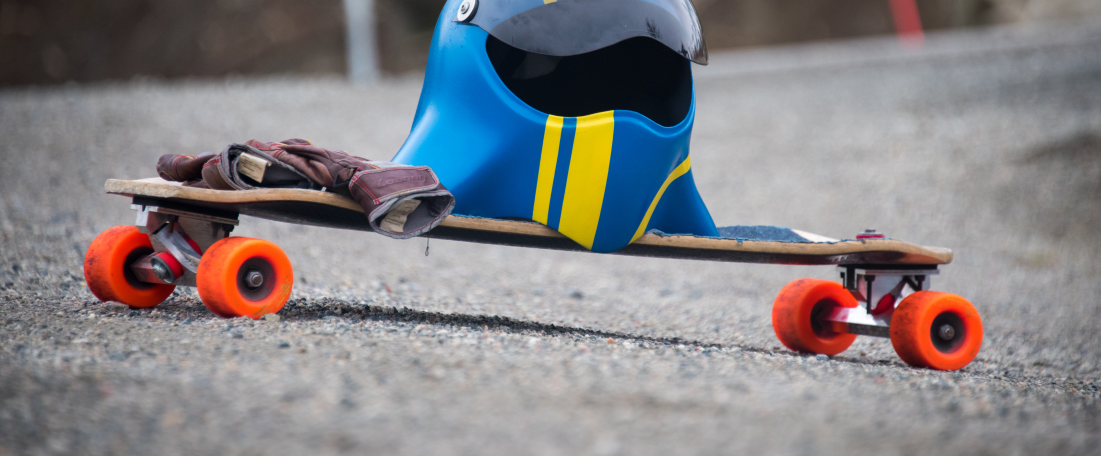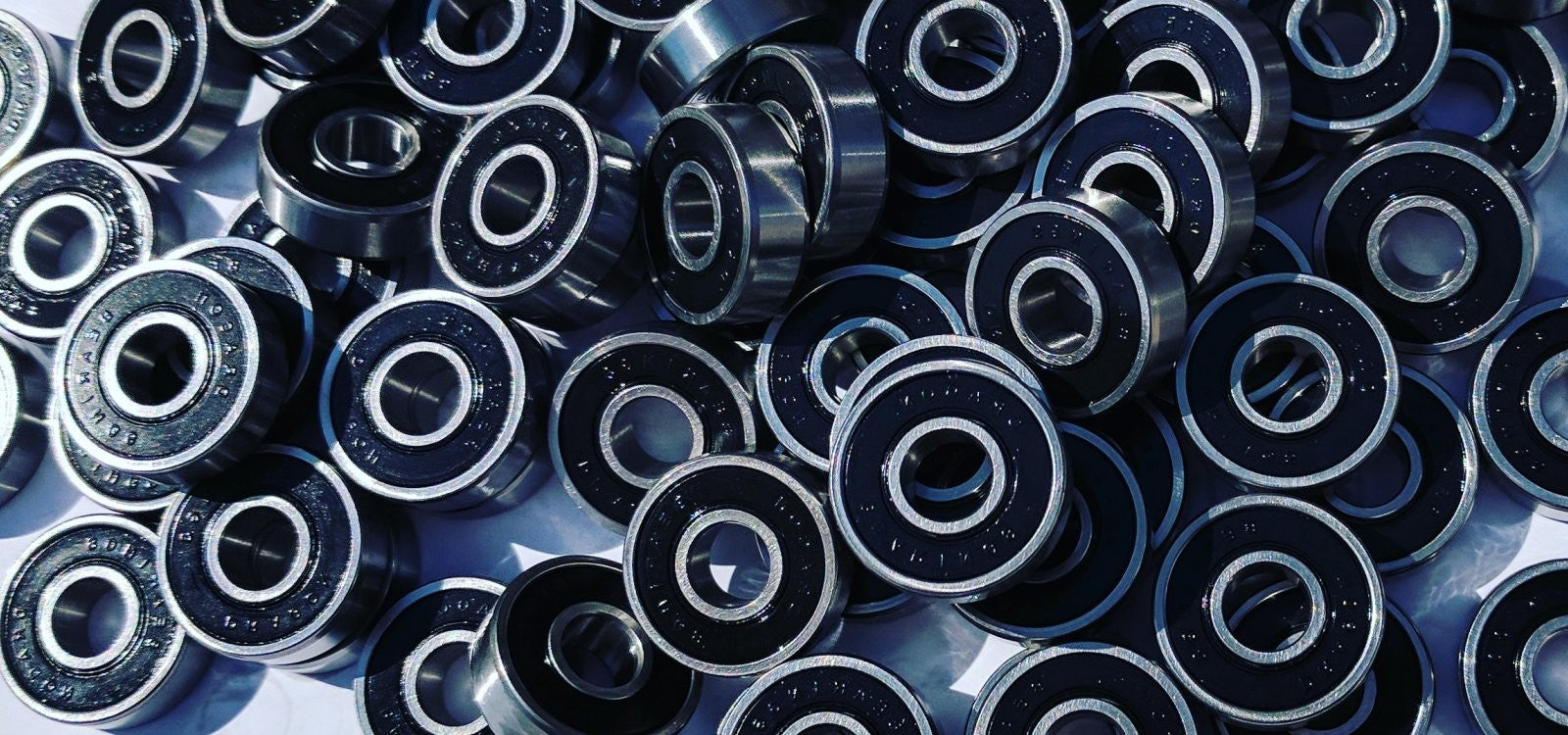Welcome to the wonderful world of bushings. It's crazy to think that such a small inexpensive piece of candy looking urethane can make such a change in your ride. But changing bushings really is the cheapest and easiest way to spice things up on your setup. In fact, changing just the bushings can make your board feel entirely new.
However, there are so many styles of bushings out there that it's easy to get lost in what would be best for you, so let us give you a hand!
Shapes and Sizes
The size and shape of a bushing determines how quickly a bushing compresses and rebounds. It makes your board more or less stable with more or less return to center. Return to center simply means how well the trucks come back to their center so the board goes straight again.
Larger bushings usually have better return to center because there is more material to push the truck hanger back to that centerline.

Bushing shapes comparison
Cones
At the turniest (#makingwords) end of the spectrum are cones. They lean quite quickly and are especially great on carving setups. Choose a cone if you want a board the turns on a dime. Don't expect too much rebound from cones as these are the smallest bushings around. We recommend checking out RipTide Cones.

Barrels
Barrels have a much more linear lean and are a little slower in the bends. The great thing about barrels is they are usable for cruising, bombing, sliding, and just about everything in between. Choose a harder durometer for more stability and a lower durometer for more turn. If you are not sure where to begin, barrels are usually a good bet. RipTide Barrels in their APS formula are an excellent choice.

Large Cones
Next up from there are bushings like RipTide FatCone or JimZ stepped cones. They have more urethane than barrels and therefore compress slower. They are still pretty linear in turns but have more support than a barrel.

Large Barrels
The most supportive end of the spectrum are RipTide Chubbies, JimZ barrels, and Venom Eliminators. They are essentially oversized barrels with a step to fit into your bushing seat. They compress the slowest due to the fat amounts of urethane. These are great for hauling some serious speed or in trucks with a very minimal bushing seat.

Tall Bushings
Any bushing with "tall" in the name just means that it has more vertical height than a standard cone, barrel, etc. This makes the bushings have more room for lean. Tall bushings are common on Long Distance Pumping (LDP) set ups and other set ups that want lots of motion from the trucks.
Note that tall bushings will only work in some trucks. Bennett Trucks are probably the most common choice for those that want to run tall bushings with ease.
Traditional (Street) Bushings
If you are buying for traditional kingpin trucks (aka TKPs) make sure you buy conventional sized bushings. Most longboard style bushings will not work the same as stock on TKP style trucks. TKPs have smaller kingpins that allow for more grind-ability, so you want to make sure your bushings actually fit on your kingpin. Oftentimes you can fit a normal sized bushing on the bottom of a TKP truck if you get rid of the washer, and then just run a short cone on top, or you can just go ahead and buy a conventional sized pack of bushings.
Durometer (aka hardness or softness)
Durometer is a way to measure the hardness of a material. Without getting too nerdy and technical, basically the higher the number with an A after it, the harder the bushing. Most bushings stop at 97A because they start to feel like rocks around that point. Generally 75A-83A is soft, 83A-87A is middle, and 90A-95A is pretty hard. However, this can be slightly different depending on how tight your bushing seat is or the angle of your trucks.
Tighter and deeper bushing seats call for softer bushings and more turny shapes, whereas the opposite is true for trucks with minimal bushing seats. Also, the lower your truck degree is the harder bushings you need to run because of the leverage you are exerting on the bushings.
The width, concave, and mounting style of your board comes into play with bushing selection as well. Wider boards and boards with lots of concave have more leverage which might mean you'll want slightly harder bushings. Top mounts exert the most leverage, followed by micro-drops, drop-throughs, dropped boards, and double-dropped boards, so adjust your durometer accordingly.
Urethane Formulas
Some bushing manufacturers use different formula urethanes for different feels. Some formulas, such as Venom's SHR or RipTide's WFB, compress faster than their counterparts. Most bushings on the market these days have a good deal of lean and rebound but they have a slightly different feel. Try the various brands to see what feels best for you.
Dialing Durometer and Shape for Weight
The two major components of dialing your bushings is the shape and weight.
| Bushing Shape | Weight Range | Durometer Range |
|---|---|---|
| Cone |
50 - 100 lb (23 - 45 kg) 100 - 140 lb (45 - 64 kg) 140 - 170 lb (64 - 77 kg) 170 - 200 lb+ (77 - 91 kg+) |
80a - 90a 85a - 95a 90a - 100a 95a - 100a |
| Barrel |
50 - 100 lb (23 - 45 kg) 100 - 140 lb (45 - 64 kg) 140 - 170 lb (64 - 77 kg) 170 - 200 lb+ (77 - 91 kg+) |
80a - 90a 85a - 95a 90a - 100a 95a - 100a |
| Large Cone |
50 - 100 lb (23 - 45 kg) 100 - 140 lb (45 - 64 kg) 140 - 170 lb (64 - 77 kg) 170 - 200 lb+ (77 - 91 kg+) |
70a - 90a 75a - 95a 85a - 100a 90a - 100a |
| Large Barrel |
50 - 100 lb (23 - 45 kg) 100 - 140 lb (45 - 64 kg) 140 - 170 lb (64 - 77 kg) 170 - 200 lb+ (77 - 91 kg+) |
60a - 85a 65a - 90a 75a - 95a 85a - 100a |
| Street/Traditional |
50 - 100 lb (23 - 45 kg) 100 - 140 lb (45 - 64 kg) 140 - 170 lb (64 - 77 kg) 170 - 200 lb+ (77 - 91 kg+) |
80a - 90a 85a - 95a 90a - 100a 93a - 100a |
Fast Ways to Change Turning Feel
Flip Washers
Ditch Washers
A Note on Personal Preferences
No two riders are created equal and what works for your buddy may or may not work for you. Experiment with different shapes to get a feel of what you like.
There are no rules here, but in general you want the bushing with the most amount of urethane on bottom (aka boardside), since your bottom bushing holds your weight on top of it. Grab some different shapes and start experimenting.
So you've got a bag of bushings and now you're ready to dial them in. I've already discussed picking the right bushings for your discipline, deck style, and weight. To dial in further you can use different sized washers. Cupped washers fit around barrels and cones quite well and will stop their lean quicker than a flat washer will. On some trucks you don't need a washer on bottom at all, which allows for more lean.
Sometimes you can run a nylon washer on bottom to allow for even quicker lean. Make sure you always have a metal washer on top however, because without it, your kingpin nut will not be able to hold your bushings in place.
Keep in mind that different bushings are better for different applications. Also keep in mind that you can bring different bushings to a hill with you for different applications. Plenty of people like to freeride on barrels or cones but then throw a fatter bushing in for going faster. Only you can figure out what shape, durometer, and brand of bushings you like. So go out and grab a bunch, and then sell the ones you don't like to your friends to get them dialed in too.
Anything we missed? Let us know: contact page or email us here.








